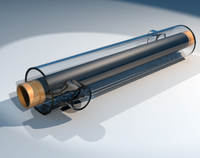
Photo from wikipedia
Abstract Energy-saving heat recovery in an industrial heat exchanger network may by impaired by fouling build-up on heat transfer surfaces of the exchangers. During longer periods of network operation, monitoring… Click to show full abstract
Abstract Energy-saving heat recovery in an industrial heat exchanger network may by impaired by fouling build-up on heat transfer surfaces of the exchangers. During longer periods of network operation, monitoring of fouling growth based on measurement data makes it possible to schedule and perform exchanger cleaning if needed for the mitigation of adverse effects of fouling. Three different methods of measurement-aided fouling monitoring are outlined: two simple methods known from literature and a least-squares based method introduced by the authors. A case study is performed on their hypothetical application in a real-life network of shell-and-tube heat exchangers used for heat recovery in crude distillation unit. Using historical measurement data recorded during three-year continuous operation of the network, the different methods are first employed to estimate the thermal effects of fouling and then used in the simulation of attainable energy and economic savings resulting from two alternative options of cleaning interventions in the network. The least-squares based method of measurement-aided fouling monitoring is identified as best suited for the evaluation of effectiveness of cleaning interventions in heat exchanger networks.
Journal Title: Applied Thermal Engineering
Year Published: 2021
Link to full text (if available)
Share on Social Media: Sign Up to like & get
recommendations!